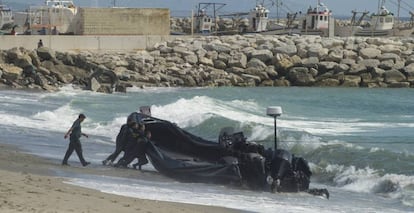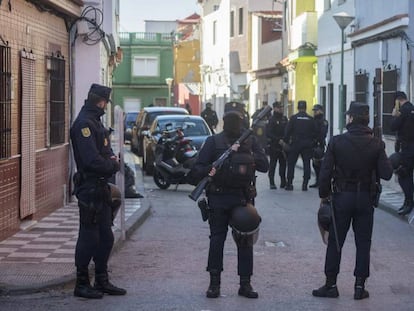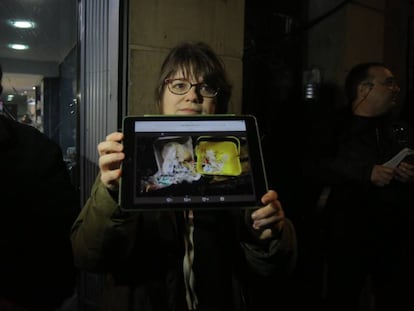Narco boats: the legal weapon of the Spanish drug trade
Drug traffickers are willing to pay up to €180,000 for speedboats to sneak in tons of hashish

The workers at the boatyard JMR Naval in Cádiz were so certain they were being used as pawns in the drug trade that when their boss was arrested for creating “narco-boats,” they simply asked: “You’re not going to arrest us, too?”
Cádiz, in southern Spain, is the gateway for hashish into Europe. Here, the 43-year-old R.F.B. decided to give up selling recreational boats and instead throw himself into the dark underworld of narco-boats.
He played a more active role by taking part in the transportation Police source
The Spanish government has threatened to ban these state-of-the-art inflatable speedboats, but so far nothing has come of the warning. Meanwhile, drug traffickers are willing to pay up to €180,000 for a 12-meter semi-rigid inflatable boat, which they use to cross the Strait of Gibraltar at 62 knots, around 120 kilometers per hour, loaded with tons of hashish that they pick up in Morocco.
But the leader of the JMR shipyard, who wound up in jail, along with 16 others as part of a joint operation between the Civil Guard and National Police, was not arrested for an activity which continues to be legal.
“We had been aware of his role as boat maker for the drug lords for a while, but now he has made mistakes. He has played a more active role by taking part in the transportation,” said a source from the investigation. In Spain, building these boats is not illegal even though, because of their characteristics, they “have no other use that is not drug trafficking,” explains Jorge Ramírez, special delegate of the Tax Agency in Andalusia.

The boats have become an ideal tool to carry hashish. Narcs from Cádiz have even looked to boat makers in Galicia (a traditional stronghold of smugglers) and England to perfect the model. In 2004, the owner of Crompton Marine was arrested in the southern Spanish city of Estepona and charged with secretly selling 30-meter speedboats. Even today, a search on boat trading websites still brings up dozens of ads for Crompton-type vessels.
The perfect narco-boat has several key characteristics: a long and narrow hull that can be up to 12 meters long, a rudder that can be steered standing up, three of four seats for the crew, and enough space in the front loading area for up to 2.5 tons of hashish. Three outboard motors with 250 horsepower, from a Japanese brand well appreciated by drug traffickers, power the boats at 62 knots, around 120 kilometers an hour.
These speedboats have become so sought after by drug traffickers that five years ago, purchasing one was considered a greater achievement than bringing in hashish, says Ramírez. The arrested boatmaker R.F.B. noticed this demand years ago, and made dozens of specialized boats “without a chassis number” at his shipyard in Puerto Real, which has direct access to the Sancti Petri water channel. After being released on bail, he might still be in business.
Life-or-death journey
A good helmsman will not charge less than €30,000 to pilot a speedboat to Morocco in just around half an hour. The drug bosses value their expertise in keeping the hashish away from the police patrols. There is also a physical risk involved: in November 2016, four suspected narcs died in a serious accident during a pursuit. Customs officers now have two semi-rigid speedboats of their own to ensure they have the “speed, maneuverability and versatility” necessary to chase and capture the drug traffickers.
In 2016, 109 boats were seized in Cádiz alone
Meanwhile, Ramírez and his colleagues are preparing to take the next step: “We have asked for the use of this type of boat to be restricted. The project has the support of the Interior Ministry and looks set to be included in the modification of the law against smuggling,” says Ramírez. The key to the ban will lie in properly defining their characteristics so that narcs cannot find legal loopholes, while still protecting basic rights. Until the ban is approved, Customs officials have at least managed to have these boats destroyed and not auctioned off, which is what happens when they are seized and handed over to the National Drugs Plan (PND).
This is the likely fate for some of the five boats that were seized by police during the joint operation Festejo. But before this can happen, there needs to be a court ruling. The Ministry of Justice admits this is causing a bottleneck of cases. In 2016, 109 boats were seized – in Cádiz alone – according to the Anti-Drug Attorney's Office. This year in Spain, PND sold off 33 boats, ceded 16 and abandoned 35.
Meanwhile, an unknown number of narco-boats continue to languish in private and public ports and warehouses. Tangled up in long, bureaucratic legal processes, the weapons of Spain’s drug trade continue to wait for their final chapter.
English version by Melissa Kitson.
Tu suscripción se está usando en otro dispositivo
¿Quieres añadir otro usuario a tu suscripción?
Si continúas leyendo en este dispositivo, no se podrá leer en el otro.
FlechaTu suscripción se está usando en otro dispositivo y solo puedes acceder a EL PAÍS desde un dispositivo a la vez.
Si quieres compartir tu cuenta, cambia tu suscripción a la modalidad Premium, así podrás añadir otro usuario. Cada uno accederá con su propia cuenta de email, lo que os permitirá personalizar vuestra experiencia en EL PAÍS.
¿Tienes una suscripción de empresa? Accede aquí para contratar más cuentas.
En el caso de no saber quién está usando tu cuenta, te recomendamos cambiar tu contraseña aquí.
Si decides continuar compartiendo tu cuenta, este mensaje se mostrará en tu dispositivo y en el de la otra persona que está usando tu cuenta de forma indefinida, afectando a tu experiencia de lectura. Puedes consultar aquí los términos y condiciones de la suscripción digital.
More information
Archived In
Últimas noticias
How Japan is trying to avert ‘digital defeat’
From digital curfews to blocking apps: How technology experts protect their children online
Why the price of coffee has skyrocketed: from Brazilian plantations to specialty coffee houses
Confined to a Cuban hospital: When electricity is a matter of life or death
Most viewed
- Pablo Escobar’s hippos: A serious environmental problem, 40 years on
- Reinhard Genzel, Nobel laureate in physics: ‘One-minute videos will never give you the truth’
- Why we lost the habit of sleeping in two segments and how that changed our sense of time
- Charles Dubouloz, mountaineering star, retires at 36 with a farewell tour inspired by Walter Bonatti
- The Florida Keys tourist paradise is besieged by immigration agents: ‘We’ve never seen anything like this’











































